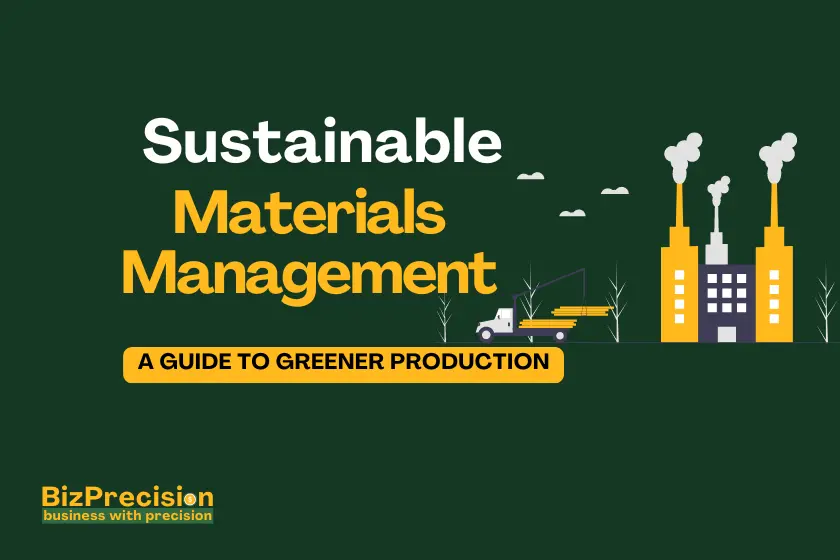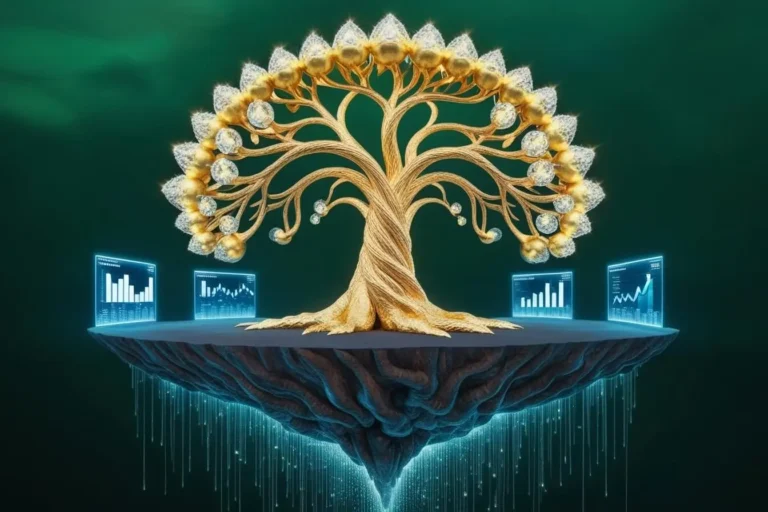Sustainable Materials Management in Manufacturing: A Guide to Greener Production
More Than Half of the World’s energy is consumed by the manufacturing sector. That’s a lot! But here’s the good news: more and more companies are finding smart ways to use materials better and waste less. They call it sustainable materials management, and it’s changing how things are made.
Sustainable materials management is all about using resources wisely. It means making things with less waste, reusing materials when we can, and recycling what’s left over. In sustainable materials management, every piece is important, from the initial raw materials to the post-product use phase, resembling a puzzle.
Why should we care? Well, it’s simple. Our planet has limited resources, and we need to use them carefully. Plus, when companies manage materials better, they often save money and make better products. It’s a win-win for business and the environment!
In this article, we’ll explore how sustainable materials management works in manufacturing. We’ll look at cool new ideas, company challenges, and success stories. Whether you’re a curious student or a professional in the industry, you’ll find plenty to learn and get excited about! Let’s delve in!
The Fundamentals of Sustainable Materials Management
What is Sustainable Materials Management?
Sustainable materials management is the backbone of green manufacturing. It’s a holistic approach to using and reusing materials productively over their entire lifecycle. The goal is simple: use less, waste less, and reuse more.
Companies rely on an effective material management process to monitor the flow of these materials and implement efficient strategies across the production line.
Sustainable materials management is like building with Legos. You make sure you use every Lego piece smartly, don’t lose any, and even find ways to use old Legos in new builds. Cool, right?
In the world of making things (that’s what manufacturing means), it’s about looking at the whole life of materials. From the moment they’re dug up or made, to when they’re used in products, and even after those products are thrown away. It’s a big-picture way of thinking that helps save resources and money.
Key Principles of Sustainable Materials Management
Now, let’s break down the main ideas behind sustainable materials management. It’s like a recipe with key ingredients:
- Reduce: This means using less stuff to make things. It’s like making a sandwich with just the right amount of peanut butter – not too much, not too little.
- Reuse: If you can use something again, do it! It’s like using a water bottle many times instead of buying new ones.
- Recycle: When you can’t use something anymore, turn it into something else. Like how old paper can become new paper.
- Recover: This is about getting value from waste. It’s like composting fruit peels to make good soil for plants.
These ideas help companies use materials in smart ways that save the planet and their wallets.
The Role of Circular Economy in Materials Management
Have you heard of a circular economy? It’s a fancy term for a simple idea: nothing goes to waste. Everything gets used again and again, like a circle that never ends.
In a circular economy:
- Products are designed for longevity and repairability
- Materials are kept in use through reuse, repair, and re-manufacturing
- Waste and pollution are designed out of the system
It’s like creating a closed-loop system where nothing goes to waste. This thinking is super important for sustainable materials management. It helps companies find clever ways to keep materials useful for a long time.
Benefits for Manufacturers and the Environment
Now, you might be wondering, “Why should companies bother with all this?” Well, there are some pretty awesome benefits:
For companies:
- Cost savings through reduced material and energy use
- Improved brand image and customer loyalty
- Increased resilience against resource scarcity and price volatility
For the environment:
- Reduced landfill waste and greenhouse gas emissions
- Conservation of natural resources
- Decreased pollution from manufacturing processes
It’s a win-win situation. Companies are happy because they save money, and the planet is happy because we’re taking better care of it. That’s pretty neat, don’t you think?
Enforcing Sustainable Materials Management in Manufacturing
Assessing Current Material Use and Waste
Before a company can start being more sustainable, they need to know what they’re doing now. It’s like checking your fridge before going grocery shopping. You gotta know what you have!
Here’s how companies can do this:
- Conduct a material flow analysis: Track what comes in and what goes out
- Perform waste audits: Identify sources and types of waste
- Analyze production efficiency: Look for areas of material overuse or inefficiency
This step is super important. It’s like drawing a map of where all the materials go. Once you have the map, you can start planning your journey to sustainability!
Setting Goals for Sustainable Materials Management
After knowing where they stand, companies need to set clear, achievable goals. In my experience, SMART goals are key to successful implementation:
- Specific: “Reduce plastic waste by 50% within 18 months”
- Measurable: “Increase use of recycled materials to 30% of total input”
- Achievable: “Enforce a closed-loop water system in the major production line”
- Relevant: “Design all new products for easy disassembly and recycling”
- Time-bound: “Achieve zero waste to landfill status by 2025”
These goals provide a clear roadmap for sustainability efforts. I’ve seen companies achieve remarkable results by setting and committing to such targeted goals.
Developing a Sustainable Materials Management Plan
Now comes the exciting part – making a plan! This is where we turn goals into action. Here’s a framework I often use with my clients:
- Prioritize actions: Which initiatives will have the biggest impact?
- Assign responsibilities: Who will lead each part of the plan?
- Set timelines: When will each initiative be implemented?
- Establish metrics: How will progress be measured?
- Allocate resources: What investments in technology or training are needed?
The plan should cover all areas of the business, from designing products to dealing with leftovers. It’s a big job, but it’s worth it!
Training and Engaging Employees
Even the best plan won’t work if people don’t know about it or don’t care. That’s why getting everyone involved is super important.
Creating a Culture of Sustainability
This is about making sustainable thinking a normal part of work. Here are some strategies I’ve seen work well:
- Appoint sustainability champions in each department
- Enforce a green ideas program to reward innovative sustainability solutions
- Integrate sustainability metrics into performance evaluations
- Organize sustainability challenges or competitions to boost engagement
When everyone’s excited about sustainability, amazing things can happen!
Key Skills for Sustainable Materials Management
To make all this work, people need to develop new skills. Some critical competencies I always emphasize are:
- Life cycle thinking: Understanding the environmental impact of products from cradle to grave
- Data analysis: Being able to measure and interpret sustainability metrics
- Systems thinking: Seeing how different parts of the production process interact
- Innovation and problem-solving: Finding creative solutions to sustainability challenges
Companies can offer training, send people to conferences, or even hire sustainability specialists. The more people know, the better they can contribute to sustainable materials management.
Strategies for Sustainable Materials Management
Reduce: Minimizing Material Input
The first big strategy is to use less stuff in the first place. It’s about being efficient and eliminating waste at the source. Here are some powerful techniques:
Lean Manufacturing Techniques
Lean manufacturing is all about cutting out waste. It’s like trimming the fat off meat. Some ways to do this are:
- Just-in-time production: Only make stuff when it’s needed, reducing excess inventory
- 5S organization: Keep everything tidy and easy to find, reducing time and material waste
- Value stream mapping: Analyze material flow to identify and eliminate inefficiencies
These techniques help use less material and energy, which is great for sustainability.
Design for Sustainability
This is about thinking ahead. When designing products, companies can:
- Use fewer different materials, which makes recycling easier
- Make products that are easy to take apart and fix
- Choose materials that are eco-friendly and last a long time
It’s like building a Lego set that’s easy to change and rebuild in different ways.
Reuse: Extending Material Lifespan
The next big idea is to use things more than once. It’s like having a favorite t-shirt that you wear again and again instead of buying new ones all the time.
Refurbishment and Re-manufacturing
This is about giving old products a new life. Companies can:
- Fix up old products to make them work like new
- Take apart old products and use the good parts in new ones
- Upgrade products instead of replacing them completely
It’s like giving your bike a tune-up and new parts instead of buying a whole new bike.
Industrial Symbiosis
This fancy term means companies sharing and trading materials. One company’s trash can be another’s treasure! For example:
- A food factory might give its vegetable peels to a company that makes compost
- A metal workshop might give its metal scraps to a company that melts them down for new products
It’s like a big swap meet where companies trade leftovers instead of throwing them away.
Recycle: Closing the Loop on Materials
Recycling becomes the solution when stuff can’t be used again. It’s about turning old materials into new ones.
In-house Recycling Programs
Many companies are setting up their recycling systems. This might mean:
- Having special bins for different materials
- Using machines that can grind up plastic parts to make new ones
- Training workers on how to sort materials properly
It’s like having a mini recycling center right in the factory!
Partnering with Recycling Facilities
Sometimes, it’s better to team up with experts. Companies can work with recycling facilities to:
- Send their waste materials to be properly recycled
- Learn about new recycling technologies
- Get recycled materials to use in their products
This teamwork helps make sure materials get a new life instead of ending up in the trash.
Recover: Extracting Value from Waste
Even when stuff can’t be recycled, there might still be ways to get something good out of it.
Energy Recovery from Waste Materials
Some waste can be turned into energy. This might mean:
- Burning waste to create heat or electricity
- Using special processes to turn waste into fuel
- Capturing gases from decomposing waste to make energy
It’s like turning trash into power – pretty cool, right?
By-product Synergy
This is about finding uses for leftovers. For example:
- A sawmill might use sawdust to make particle board
- A brewery might use leftover grain to feed farm animals
- A chemical plant might use waste heat to warm nearby buildings
It’s all about being creative and seeing value where others might just see trash.
Innovative Technologies in Sustainable Materials Management
Advanced Materials for Sustainability
Science is coming up with some amazing new materials that are great for the planet. These include:
- Bio-based plastics made from plants instead of oil
- Super-strong materials that make products last longer
- Self-healing materials that can fix small damages on their own
These new materials are like superpowers for sustainability!
Digital Tools for Material Tracking and Optimization
Technology is making it easier to keep track of materials. Companies are using:
- Software that follows materials through the whole production process
- Sensors that measure how much material is being used in real-time
- Artificial intelligence that predicts when machines might waste materials
It’s like having a super-smart assistant helping to use materials wisely.
AI and Machine Learning in Materials Management
Computers are becoming highly proficient at finding patterns and solving problems. In materials management, AI can:
- Figure out the best way to cut materials with the least waste
- Predict when recycling equipment needs maintenance
- Suggest new ways to use leftover materials
It’s like having a genius friend who’s always thinking of new ideas to save resources.
3D Printing and Additive Manufacturing
3D printing is changing how things are made. It can help with sustainability by:
- Using only the exact amount of material needed
- Making it easy to create spare parts, so products last longer
- Allowing products to be made closer to where they’re needed, reducing transportation
It’s like having a magic wand that can create things with less waste!
Overcoming Challenges in Sustainable Materials Management
Initial Costs and Return on Investment
One big challenge is that setting up sustainable systems can require upfront investment. Companies often worry about:
- The cost of new equipment
- Training expenses
- Potential disruptions to production
But here’s the good news: many companies find they save money in the long run. Using less material and energy often means lower costs over time. It’s like spending money on a good bike now, so you don’t have to buy bus tickets later.
Technical Barriers and Solutions
Sometimes, the technology just isn’t there yet to do everything we want. Common challenges include:
- Recycling complex, multi-material products
- Developing sustainable alternatives for specialized materials
- Scaling up new technologies
But smart people are working on these problems every day. New solutions are popping up all the time, like fungi that can eat plastic or new ways to sort mixed materials.
Regulatory Compliance and Standards
Laws about how companies handle materials can be tricky. There are rules about:
- How to dispose of certain materials
- What can be called “recycled” or “sustainable”
- How to report on environmental impact
Keeping up with these rules can be hard, but it’s important. Companies that do it well often find they’re ahead of the game when new laws come in.
Supply Chain Collaboration for Sustainability
Making products often involves many companies. Getting everyone to work together on sustainability can be tough. Challenges include:
- Making sure all suppliers follow sustainable practices
- Sharing information about materials across different companies
- Agreeing on standards for sustainable materials
But when companies work together, amazing things can happen. They can share ideas, split costs, and make bigger changes than they could alone.
Measuring Success in Sustainable Materials Management
Key Performance Indicators (KPIs) for Materials Management
To know if all this hard work is paying off, companies need to measure things. Some important things to track are:
- How much waste is produced per product
- The percentage of recycled materials used
- Energy used in production
- How long do products last before they need to be replaced
These numbers help companies see if they’re getting better and where they still need to improve.
Life Cycle Assessment (LCA) in Manufacturing
LCA is like looking at a product’s entire life story. It includes:
- Where materials come from
- How the product is made
- How it’s used
- What happens when it’s thrown away
This big-picture view helps companies understand the total impact of their products and find ways to make them more sustainable.
Reporting and Transparency in Sustainability Efforts
Telling others about what they’re doing is important for companies. This might include:
- Publishing yearly reports on sustainability efforts
- Sharing success stories and challenges
- Being open about goals and progress
This openness helps build trust and can inspire other companies to do better too.
Continuous Improvement Strategies
The work of being sustainable never really ends. Companies need to keep getting better. This might mean:
- Regular reviews of their sustainability plans
- Asking workers for new ideas
- Staying up to date with new technologies and methods
It’s like always trying to beat your high score in a game. There’s always room to do even better!
Conclusion: The Future of Sustainable Materials Management
Wow, we’ve covered a lot of ground! Sustainable materials management in manufacturing is like a gigantic puzzle, and we’ve just put all the pieces together. Let’s recap the cool stuff we learned:
- It’s all about using materials wisely — less waste, more reuse.
- Companies can save money and help the planet at the same time. Pretty neat, right?
- New tech like AI and 3D printing are making it easier to be sustainable.
- It takes teamwork—from designers to factory workers to recycling pros.
But here’s the thing: this isn’t just for big companies. We can all think about how we use stuff in our daily lives. Do we really need that new gadget? Can we fix something instead of tossing it?
So, what’s next? If you’re curious about sustainable materials, keep learning! Maybe you’ll come up with the next big idea that changes how we make things. Remember, every small step counts. Together, we can make a huge difference to our planet!






